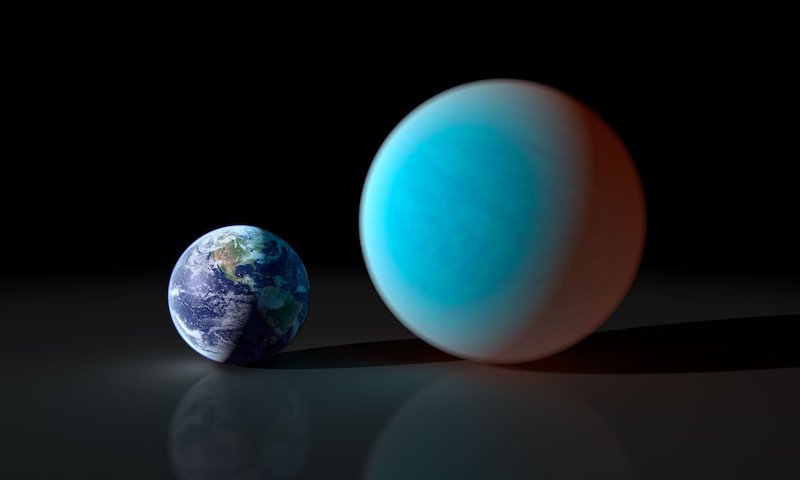
Our planet Earth is the only world in our solar system with liquid water on its surface. In this solar system, Earth’s oceans are unique. But scientists think there are many more ocean worlds elsewhere in our Milky Way galaxy. In late October 2021, NASA released a new study suggesting that scientists can find hidden alien oceans on distant exoplanets via the use of chemistry. The study showed that, on worlds that have oceans, the chemical makeup of the atmosphere is distinctly different, as compared to worlds lacking oceans on their surfaces.
The new peer-reviewed research paper was published in the The Astrophysical Journal Letters on October 28. It’s also availble as a free preprint on arXiv.
Using chemistry to find hidden alien oceans
The new study proposes that astronomers could detect oceans on exoplanets by analyzing the chemistry of their atmospheres. Generally, this could apply to Earth-sized worlds, super-Earths or even some sub-Neptunes (any planet with a radius smaller than Neptune but larger than Earth). The paper focuses on planets that are between 1.7 and 3.5 times the diameter of Earth. Telescopes with spectrometers, including the upcoming James Webb Space Telescope (JWST), can identify the chemical makeup of the atmospheres of some of these planets. They can find gases such as oxygen, carbon dioxide or methane, which could be hints of life.
That’s exciting, but such chemical analyses can reveal other things about these planets, too. It could find evidence for oceans, which also has big implications for habitability, of course.
The 2022 lunar calendars are here. Order yours before they’re gone!
Too hot for liquid water or just right?
At least in some cases, those telescopes can help determine whether there is liquid water on the surface of any of these planets. More specifically, by analyzing the chemicals in the atmosphere, scientists can estimate whether the surface temperature is too hot for liquid water.
So which chemicals might be indicative of an ocean beneath the clouds? One finding would be carbon dioxide and nitrogen in the atmosphere, where the nitrogen molecules consist of two nitrogen atoms. Why is that significant? It would be evidence that the planet’s atmosphere is cooler and thinner, ie. more like those on terrestrial planets like Earth. It would indicate that thermochemical equilibrium (chemical equilibrium) has not occurred on that planet.
In thermochemical equilibrium, the chemistry of the atmosphere is altered. This happens when the planet’s atmosphere is composed primarily of hydrogen, which is common for sub-Neptune worlds. In those cases, the carbon and nitrogen are in the form of methane and ammonia, and the atmosphere is significantly thicker.
In those scenarios, the thick atmosphere, like the ones on the gas and ice giants in our solar system, traps heat. Thermochemical equilibrium will occur when the temperature reaches 1,430 degrees F (770 degrees C). That’s too hot to support liquid-water oceans.

Missing ammonia
Another key indicator for possible oceans is that something is missing in the atmosphere: ammonia. Because ammonia is highly soluble in water, it would be nearly non-existent on ocean planets. So planets with massive oceans should have virtually no ammonia in their atmospheres. The pH (acidity) level of the ocean, however, would also affect how much ammonia were still present, if any.
Also, there should be more carbon dioxide than carbon monoxide on ocean worlds. If there were both a lack of ammonia and an excess of carbon dioxide in a planet’s atmosphere, this would be compelling evidence for an ocean world. As Renyu Hu at NASA’s Jet Propulsion Laboratory (JPL), who led the new study, stated:
If we see the signatures of thermochemical equilibrium, we would conclude that the planet is too hot to be habitable. Vice versa, if we do not see the signature of thermochemical equilibrium and also see signatures of gas dissolved in a liquid-water ocean, we would take those as a strong indication of habitability.
Hu continued:
We don’t have direct observational evidence to tell us what the common physical characteristics for sub-Neptunes are. Many of them may have massive hydrogen atmospheres, but quite a few could still be ‘ocean planets’. I hope this paper will motivate many more observations in the near future to find out.

Future observations
NASA’s James Webb Space Telescope (JWST), due to launch on December 18, will have a spectrometer capable of analyzing the atmospheres of some of these worlds. As noted in the paper:
These gases lead to distinctive features in the planet’s transmission spectrum, and a moderate number of repeated transit observations with the James Webb Space Telescope should tell apart a small atmosphere vs. a massive one on planets like K2-18 b. This method thus provides a way to use near-term facilities to constrain the atmospheric mass and habitability of temperate sub-Neptune exoplanets.
In other words, JWST will be able to identify signs in the atmospheres that can reveal ocean-supporting planets. It will be exciting to see what JWST finds in the months and years ahead!
Bottom line: NASA scientists say that to find hidden alien oceans on distant exoplanets, use chemistry. Ocean worlds will have distinctly different atmospheric compositions from planets that don’t have oceans, including a lack of ammonia.
Source: Unveiling Shrouded Oceans on Temperate sub-Neptunes via Transit Signatures of Solubility Equilibria versus Gas Thermochemistry, Preprint











